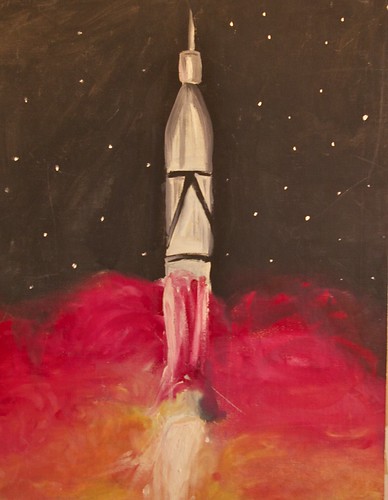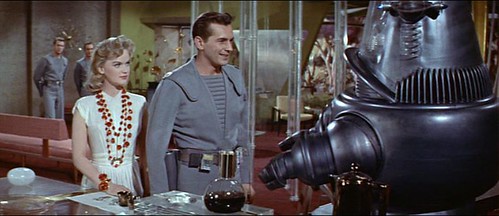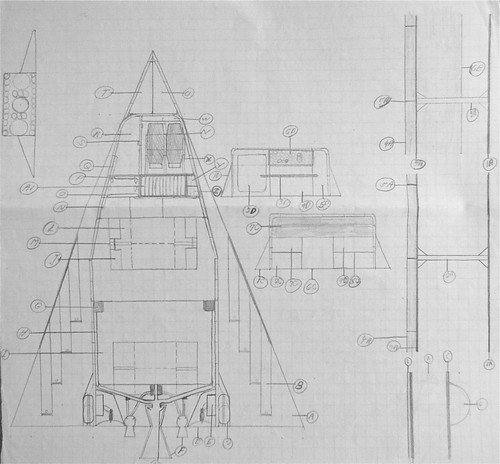One evening in the fall of 1957 my father took me outside. He pointed up to the sky and said “That’s Sputnik.” I’m not sure I saw the (moving) speck of light he was pointing to but I believed him. Yes, there was Sputnik up there in the sky. A man-made object going around the earth.
A first.
I was almost ten years old at the time and that's the first time my mind connected with world history. That’s the oldest event I can remember that is important to me as an individual and also important in the history of the world. No doubt I had some awareness of other world-scale events as a young child, but I don’t remember them. This one I do.
From Here to the Moon
Some time in the mid-1990s I was working a trade show in Orlando, Florida. things were slow at the booth so I decided to ditch the last day and head over to Kennedy Space Center. I’d grown up watching satellite launches on TV and was curious about the place they had been staged from.
So I drove east through central Florida, which was much like a desert except that it had lots of plants. I arrived at Kennedy Space Center around noon. I parked the van wherever, walked past a parade of rockets on display, and purchased a ticket for one of the standard tours. The NASA guides took us through some launch pads, around and even up into a couple gantry towers, and we saw a couple control rooms–one, as I recall, mocked up as though a mission were in progress. And then we saw it, a Saturn V suspended from the ceiling of a long, low building. The physical scale was humbling, but it was more than that. Big is big – that Saturn was the length of a football field – but this earth and these buildings birthed journeys that took us to the Moon. There is sacred energy in this soil and these structures where humankind ventured beyond ourselves, not merely into space, but into an almost living presence above and beyond.
That’s what floored me. This ground, this very ground where I was standing, was once tangibly connected to the moon 238,900 miles (384,400 km) away. Men had suited up in a building on this site, gotten into a small capsule atop a large rocket, and four days later got out and walked on the all of a sudden here and now beneath our feet, the moon. And then – How they ever did it I'll never know because when you've been there how do you ever but you have no choice, do you? You want to live, to see your wife and children again – they got back into their landing craft, took off from the moon, and returned to earth in another four days. Eight days from the earth to the moon and back.
Incredible.
And it really happened. In my life time, four decades ago. But there’s no guarantee that it will happen again in my remaining years, much less that we’ll travel to Mars or mine the asteroids.
Dreams and Reality
I don’t know when I first started thinking about space travel. Walt Disney featured it on his evening TV show, which started in 1954; there were science fiction movies, both in the theaters and on TV, and there were comic books. But I have few specific memories of those things.
The earliest thing I can put my finger on is this painting I did as a child:
There’s no date on it, but I’d guess I did it when I was eight or nine. I was somewhat older when I did this painting, though it too is undated:
The technique says I was older, as does the medium. This one is in oil paints while the other is in tempera. I used tempera for the first year or two when I took art lessons; then my teacher, Glenn Brougher, moved me to oils.
I’d guess that I painted the second one from a photograph. It depicts a Jupiter-C launch vehicle (compare with the photograph here; notice the painted markings).
In between those two paintings I would have seen Forbidden Planet, a classic science fiction film the first showed in the theaters in 1956. It featured a flying saucer and Robbie the Robot. I drew picture after picture of both.
When I was a bit older, in my tween years, I built plastic models of various things, battle ships, sailing ships, people (e.g. a viking), and spacecraft. I also designed my own space ships. Here’s a fragment of one such design:
I’m sure I had a name for every one of the parts identified by a call-out, though I may not have written those names down anywhere. If I did, I no longer have those scraps of paper.
By the time I went entered college in 1965 I was no longer interested in designing rockets, much less in being an astronaut. By the time men first landed on the moon I’d become a quasi-hippie and was rather blasé about the space race. I doubt that I watched the moon landings on TV. A decade later I read my way through a pile of science fiction while working on my dissertation (on cognitive science and literary theory). I enjoyed most of it and thought Samuel Delaney was the best of them and a fine writer by any standards.
I spent the summer of 1981 working with NASA. They’d decided their computer operation was not up to university standards and assembled a team of academics to draft a set of recommendations. I was on the team. We worked out of a University of Maryland conference center on the edge of a cliff overlooking the mouth of the Susquehanna. Those buildings had once been a summer home for the DuPonts.
Our charge was peculiar. Yes, we were to come up with strategic recommendations to bring NASA’s computing infrastructure up to snuff. But there was something else at stake.
Morale at NASA was in bad shape and good people were leaving. The agency had been created to put a man on the moon. Yes, there were the scientific satellites too, but the spirit of the agency was bound up in the grand adventure of walking around on the moon, looking under lunar rocks, and putting one in your pocket to show the wife and kids. Once that mission had been accomplished, further moon shots terminated, and the spirit that had animated NASA began to die. The space shuttle had no pizzazz nor did the science missions.
I was surprised and a bit shocked.
Could we come up with some kind of sexy information technology stuff that would put some life back into the agency? That’s what NASA wanted us to do. The previous year, for example, NASA ran a summer study that dreamt up some “blue sky” computer-tech based missions, including a plan to create an unmanned self-replicating factory on the moon. Did we think NASA should do something like that?
At the same time we had to point out, for example, that their procurement cycle was roughly as long as a generation of computing tech, making it almost impossible to keep current with the technology. By the time a procurement order had been approved the technology was obsolete. Then there was the fact that the civil service classification system recognized mathematicians and engineers, but not computer programmers. Things like that.
In fact, people in NASA knew all of those pesky little problems. They brought us in so they could present them to us for packaging and gift-wrapping. That’s what consultants do; tell organizations things they already know, but want someone else to say: do it. Which we did.
How do you reconcile the need to solve such nuts and bolts problems with the need to come up with a sexy morale-boosting mission for the organization that put human beings on the moon? That’s two different worlds, two different mindsets.
Beyond the Dream
That all came back to me almost twenty years later – we’re at the brink of the new millennium now – when I stood there at Kennedy Space Flight center looking up at that Saturn V. It stretched from here to there. It was huge, yet, up close, it didn’t feel that big. And the Apollo capsule was tiny. To the moon, in that?
Yes. To the moon. In that. And back.
First the moon, then Mars, then the rest of the solar system. And then the stars. That’s what Walt Disney told us back in the 1950s. That’s how it was supposed to go.
But that’s not what happened. Landing a couple of men on the moon was enormously difficult, expensive, dangerous, and it had little practical value. The astronauts, scientists, and engineers may have been in it for the adventure, but the politicians allocated the money because it played well in the Cold War against the Soviet Union.
Once we’d won the space race, the political point had been made. There was no need for any more costly adventures (of a non-military kind). NASA switched modes from Space Adventure, Inc. to Space Transportation, Inc. and fired space shuttles into low earth orbit.
The moon landing that was supposed to be the beginning turned out to be the end. But it was an end that left us at the threshold of a new world. Ever since then we’ve been trying to get our footing in that New World.
The trouble is we don’t yet realize that we ARE in that new world. We keep thinking that THAT new world is out there ahead of us, that new technological miracles will take us There. No, there is no new world out there. The technical miracles are those of this, the New World we’ve been living in for the last quarter century or so.
It’s as though those ancient Israelites had crossed over the river Jordan in the middle of the night, asleep and with their eyes closed. When they woke up in the morning, they WERE in the Promised Land, but they didn’t realize it. And so kept on journeying.
Believe it or not, this world, with all its problems, this is the Promised Land. And one day we will journey to Mars, and to the asteroids, and send a ship out there to the stars. But we’ve got a lot of work to do Earth before that happens. We’ve got to clean house and get right with Gaia. That won’t be easy.





Great to see those paintings again and the spaceship design. And,
ReplyDeleteyes, I recall the challenge presented to us by Sputnik. The original TV series of Star Trek was, for me, the last of those years of anticipating the New World. Thanks for your discussion!
Yep, the original Star Trek. I've just taught myself how to play that theme song, but I'm calling it Jersey City Rising.
ReplyDelete